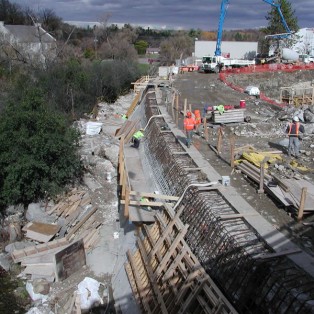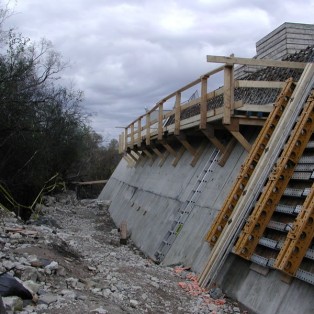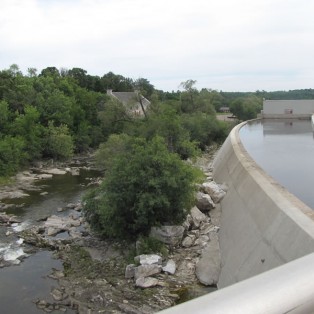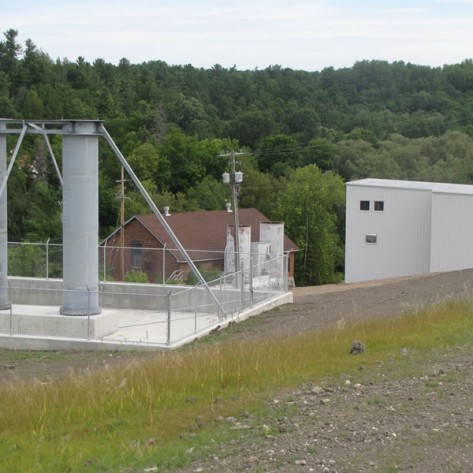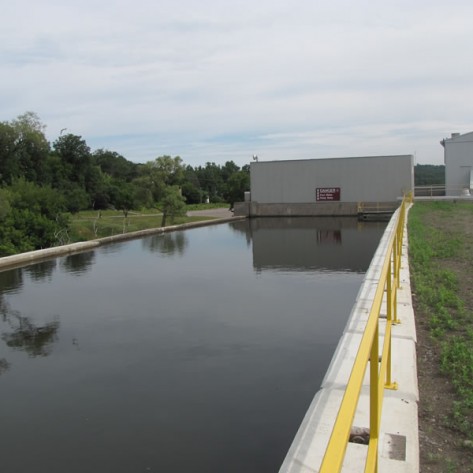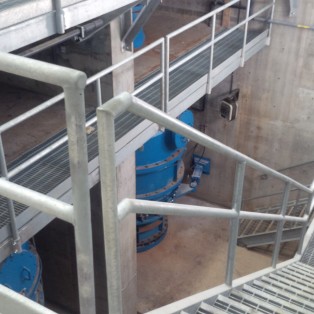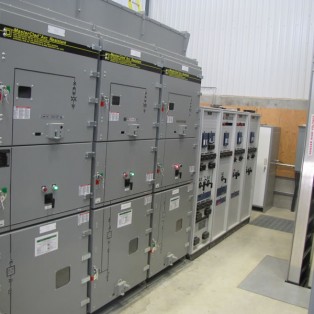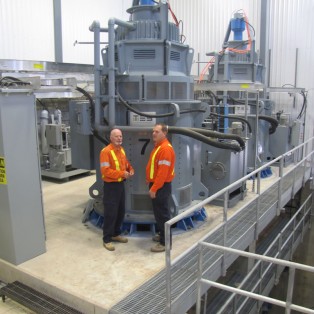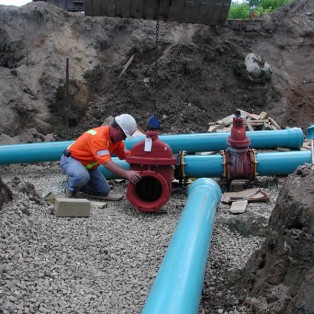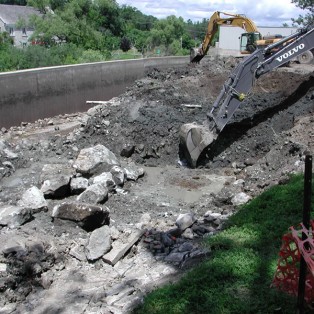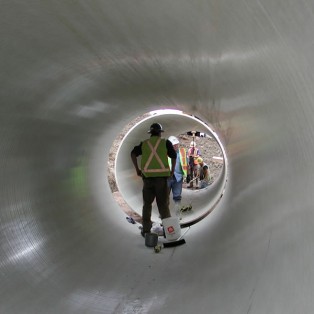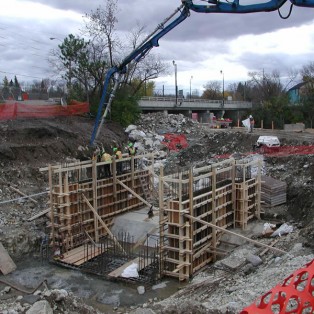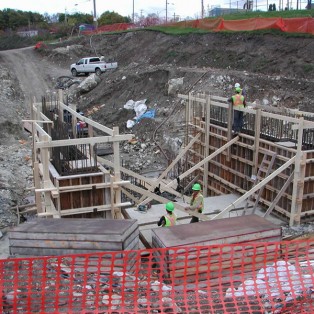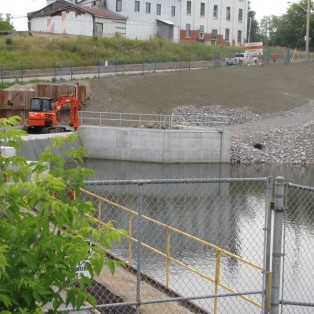- How will the Thomas Low Generating Station benefit the community?
- What was constructed?
- Why did RPG build the TLGS and redevelop its facilities?
- How will this project protect the Town’s water supply and wastewater treatment?
- Will the two older generating plants continue to operate?
- How much did the project cost?
- Who is paying for this project?
- What are some of the other economic benefits of this project?
- What other options were considered?
- How long did it take to plan this project?
- Who was Thomas Low?
How will the Thomas Low Generating Station benefit the community?
RPG will continue to provide a reliable source of renewable energy, double its capacity to generate hydro-electric power, and provide long-term dividends to the Town of Renfrew because of the construction of the Thomas Low Generating Station and repairs to the Upper Dam.
- RPG’s investment in the TLGS results in a doubling of generating capacity to deliver clean, reliable, and renewable energy for 50 to 70 years. Local citizens will benefit for years to come because of long-term dividends issued to RPG’s sole shareholder, the Town of Renfrew.
- TLGS—RPG’s main generating plant, has an installed capacity of four megawatts (4 MW). That’s double the capacity of the two existing waterpower generating stations built more than 100 years ago. The existing plants’ control systems, last improved in the 1990s, were upgraded to integrate with the new TLGS.
What was constructed?
The new TLGS was constructed. Major repairs were completed to aging infrastructure at the Upper Dam and the Upper Plant intake canal—these repairs were identified in a dam safety assessment conducted by OEL/Hydrosys in 2007.
The project consisted of:
- Repairs to the Upper Dam and four sluiceways
- Repairs to the inner and outer walls of the existing canal
- New retaining walls on both sides of the intake that diverts water from the Bonnechere to the canal
And building:
- A new intake within the Upper Plant canal
- The new Thomas Low Generating Station, located adjacent to the existing Lower Plant
- Tailrace (channels to carry water) to join the existing Lower Plant tailrace
- A new buried water conveyance structure to channel the flow from the canal to the TLGS and consisting of a double penstock (closed pipe that creates head pressure with an increasing vertical drop)
- Two surge stacks to control sudden increases in flow velocity
- A new access road
- A new transmission station
- Stairway access to the Swinging Bridge
- A new, larger trunk sewer pipe—RPG had to change the route for the penstock which meant moving the Town’s aging 18” sanitary sewer installed in the 1960s. Since the sewer pipe was nearing the end of its life, RPG installed a new 24” trunk sewer pipe to carry waste from a large portion of Renfrew, at no cost to the Town of Renfrew. The larger pipe will accommodate future growth within the town.
Key highlights of the Thomas Low GS:
- Two Kaplan turbines 2000 kW each with variable pitch blades
- Boosts production capabilities for available water—conservative estimate for the production increase is 20%
- Features state of the art technology for protection, synchronizing and unit controls
- Ensures connection authority grid compliance
- Has SCADA remote smart-phone alarming and user interface for 7/24 operation
- Monitors trending and reporting, and identifies issues
Why did RPG build the Thomas Low Generating Station and redevelop its facilities?
Renfrew’s two existing waterpower stations (the Upper Plant and Lower Plant) have been generating hydroelectric power for more than 100 years. RPG’s decision to upgrade was influenced by four factors:
- RPG needed to upgrade aging infrastructure, identified in a dam assessment, to continue producing a clean, reliable supply of hydroelectricity and maintain continuous flows and levels in the Bonnechere River.
- RPG must maintain reliable water levels to support the Town of Renfrew’s water treatment plant to supply drinking water and water for fire protection, and to diffuse treated effluent from the wastewater treatment plant.
- RPG is a for-profit company. Its ability to increase its capacity to generate and sell renewable energy by constructing the Thomas Low Generating Stat was made possible because of access to Ontario’s Green Energy’s financial incentives. They included stable prices for long-term contracts through the Feed-in Tariff Program (FIT), and the ability to undertake expand and redevelop facilities under the Hydroelectric Contract Initiative (HCI).
- As a partner, RPG supports the Town of Renfrew’s goal of maintaining a stable and sustainable community in which to live, work and grow by maintaining critical community infrastructure and, starting in 2016, by providing the town with long-term dividends.
How will this project protect the Town of Renfrew’s water supply and wastewater treatment?
- The intake used to draw water for the Town of Renfrew’s water treatment plant, located upstream from the generating facilities, depends on the river’s water level which is regulated by the upper dam. The upper dam serves two purposes: it keeps a reservoir for the Town’s water supply, and stores water from which RPG makes power. Protection of the Town of Renfrew’s supply of water is a priority.
- RPG also maintains continuous flows to ensure treated wastewater from the Town of Renfrew’s wastewater treatment plants are adequately mixed when they are returned to the river.
Will the older generation plants continue to operate?
- The two older facilities—each having an installed capacity of one megawatt (1 MW)—will operate if the river flow exceeds the maximum operating capacity of the TLGS—during the spring freshets, or when the TLGS requires maintenance or repair.
How much did the project cost?
- The cost was $24.7 million.
Who is paying for this project?
- RPG will repay its $24.7 million loan with the Toronto-Dominion Bank over a term of 20 years. RPG required and received the support of its sole shareholder, the Corporation of the Town of Renfrew, to serve as guarantor.
- RPG provides an annual interest payment to the Corporation of the Town of Renfrew of $67,000. In addition, a dividend will be determined once RPG has operated the new and upgraded facilities site for one year.
- RPG will continue to operate at a profit.
- As a for-profit, RPG looked at opportunities provided through Ontario’s Green Energy incentives to expand the waterpower potential of the Bonnechere River. In planning the redevelopment, RPG was approved for Ontario HCI’s redevelopment program in which Ontario contributes to capital costs through contract rates. RPG’s current contract with Ontario Power Authority, now amalgamated with the Independent Electricity System Operator, is expected to increase.
What are some of the other economic benefits of this project?
- A large portion of RPG’s investment created jobs and purchased materials and services from within a 60 km radius of Renfrew.
- The Town of Renfrew receives a $67,000 annual interest payment from RPG based on invested capital at the company’s forming in 2000.
- The Town of Renfrew will also receive a long-term dividend; the amount will be determined once the TLGS has operated for a year.
- Aging infrastructure has been replaced with new or upgraded facilities that will serve us for 50 to 70 years.
- The increased efficiency will produce 50% more power using the same volume of water.
- Power produced by RPG helps to keep power rates down because its power that doesn’t have to be supplied by Hydro One to Renfrew Hydro Inc.—a process that incurs a delivery charge.
What other options were considered before the decision to build TLGS and upgrade infrastructure?
- Redeveloping the two existing stations was not cost-effective, and there were serious concerns that work couldn’t be contained within the existing footprint.
- The Clear Point 3.6MW proposal would have been geographically and operationally separate from RPG’s existing facility; it was ruled out because of economic uncertainties, and the necessity to use a previously undisturbed shoreline.
How long did it take to plan the project?
The project has been in the planning for 10 years—involving five major stages and many stakeholders: the feasibility analysis, developing the business case and financing, planning including environmental approvals, permitting from at least a dozen government agencies, and a construction schedule that responded to high levels of spring run-off, winter conditions, and habitat protection. Construction started in June 2013.
Who was the Hon. Thomas Low?
 Photographer: Jules Alexander Castonguay
Photographer: Jules Alexander Castonguay
Source Library and Archives Canada, PA 804882
Renfrew Power Generation’s (RPG) decision to name its new waterpower generating station, the Thomas Low Generating Station, is a testament to one of Renfrew’s progressive leaders. The new generating station stands next to the weathered but resilient red-brick building that housed Low’s generation units for more than 100 years.
Born in Quebec City in 1871 and educated in Pembroke, Thomas Andrew Low came to Renfrew where he became an entrepreneur, lumberman, industrialist, and parliamentarian.
The Entrepreneur
Low’s ambitions were inspired by the belief that he could produce much more electricity using the waterpower of the Bonnechere River to supply the Town of Renfrew—power to run its water system. Harnessing water power to create electricity gave Renfrew a distinct edge, one that made Renfrew a successful manufacturing centre.
In 1899, when Martin Luther Russell’s sawmill came up for sale, Thomas Low—Russell’s former secretary—bought the land between Mutual Street and the Bonnechere River together with the water rights. Low had left Russell’s employ to run a sawmill with his partner, John Knight, at the Fourth Chute. Unfortunately, the sawmill burned to the ground in 1894. Low used the land he purchased from the Russell estate to house a lumber yard where he sold dressed and undressed lumber, laths and shingles. Just across the river stood W.A Mckay’s grist mill—a mill with lighting created from electricity generated by water power from the river with enough left to supply nearby houses. Renfrew Electric Power’s A.A. Wright was also supplying the Town of Renfrew power for five arc lights on major streets.
Low, believed his water rights had greater potential, so he and Mackay decided to work together—successfully convincing Alex Barnet, P.S. Stewart, John Ferguson, MP, and Dr. S.H. Murphy to provide the financing—and forming Renfrew Power Company (RPC).
Low was particularly interested in convincing Town Council and its Waterworks Committee of the merits of using electricity to power the town’s waterworks system instead of steam, fuelled by wood.
In 1902, construction of RPC’s dam and a building, known today as the Lower Plant at RPG, housing two power generation units was completed. Electricity was supplied to light stores and houses and the town’s street lighting. A contract was signed later between the Town and RPC to supply electricity to operate the waterworks.
In 1911-12 the Town built a second dam and a building—known as the Upper Plant today—to house another electrical generation station and a pump house for the waterworks in large part because of weather conditions in 1908—the year the Bonnechere went dry—this very dry year greatly reduced the flow of water in the Bonnechere River. Fortunately, the original steam-driven turbines, kept as backup, provided the power needed during the dry spell. Town Council bought the property and water rights from A.A. Hough above the highway bridge and below the bridge, and after some negotiations, the water rights of the owners on the north side of the river.
Low’s RPC was eventually sold to the Town in 1917.
The Industrialist
Thomas Low was a man of multiple interests: creating many local jobs by working with other industrialists including M.J. O’Brien. Low was president of Renfrew Flour Mills (the largest in the county); Renfrew Electric (manufacturing irons, toasters, percolators), Renfrew Refrigeration, Renfrew Manufacturing (planning mill) and the British Canadian Export Company. He was the founder of Renfrew Machinery (produced popular cream separators, and shells and fuses for shell cases during WW1), and the Knitting Mill. Electricity for some of these companies was generated initially by Renfrew Power Company.
The Parliamentarian
The Hon. Thomas Low, a Liberal, was elected MP for Renfrew South for four terms: 1908, 1911, 1921 (resigned after accepting an office of emolument under the Crown), and again after winning the 1923 By-Election. Prime Minister MacKenzie King appointed Low Minister without Portfolio from 1921-1923 Low hired a young university graduate from Renfrew as secretary—Charlotte Whitton who went on to be Canada’s first female Mayor. Low served as Minister of Trade and Commerce from 1923-1925.
The Citizen
With Town Council’s approval, Low at his own expense, had the old Albion Square at the corner of Raglan and Railway streets made into a park in 1918. Council named it Low Square. Low’s final gift to the town was the Soldiers’ Memorial Cenotaph, unveiled in 1931 to honour the men from Renfrew and the area who died fighting for Canada during WWI. Thomas Low did not see the unveiling. He died at the age of 59 on February 9, 1931.
Sources:
The Story of Renfrew, Heritage Renfrew, Juniper Books
Renfrew’s Hydro by Harry Hinchley

